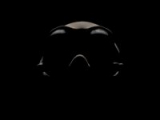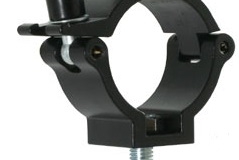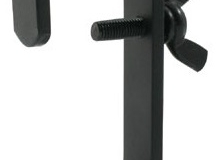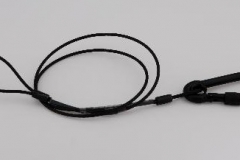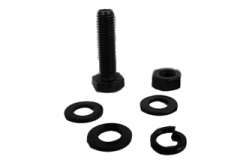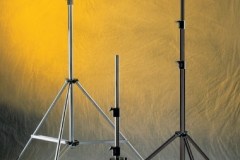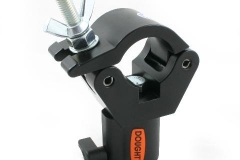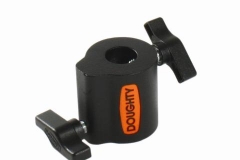Positions for Rigging Lighting
Overstage
The horizontal scaffold tubes or trusses that are hung over the stage are known as bars.
Lighting bars over the stage are numbered from the proscenium arch towards upstage.
The bar closest to the proscenium is LX1 (or Electrics 1 or Number 1 Electric in the USA). The numbers increase for the full-stage width lighting bars going upstage.
Other positions are named after their location.
Side-Stage
Vertically-mounted bars are called Booms, and enable lighting equipment to be rigged close to the stage floor, lighting across the stage. They can also be mounted above one another for the length of the boom. Booms are named by their position (e.g. SR Boom #1 is the downstage boom on stage right (the left of the stage from the audiences’ point of view)).
Front of House
Bars just downstage of the proscenium at high level are known as Advance bars.
Rigging positions are then named after their location.
Balcony Bar is on the front of the main Balcony seating area. Box Booms are beside the auditorium seating boxes. Circle Bar is on the Circle. etc.
Direction of light is all important
The type of lighting equipment you have at your disposal is far less important than where the light actually is coming from. Your choice of which lighting angles you’d like to use for your production will help you to decide where you need the light to come from. The rest of this page contains information about the rigging alternatives that you may have at your disposal in your venue.
Bars
Overhead horizontal lighting bars are the most common lighting position in any type of theatre.

Most theatre spaces have scaffold bars (48mm diameter) to rig lanterns from.
If the bars are equipped with sockets, they are internally-wired bars (often abbreviated to IWBs) which use the bar to carry the wiring to the sockets.
On a lighting plan, the lanterns are shown with the bar drawn ‘underneath’ them as shown right.
Lanterns are rigged onto bars using clamps – either a Hook Clamp or a Half Clamp can be used. (C Clamps are used in the USA). In combination with an M10 bolt and wing nut, any lantern can be rigged easily. A safety wire is also needed to hold the lantern in the air if the primary support (clamp) should fail.
Vertical Extension Tubes (made by City Theatrical) can be used to rig a fixture at a certain height below a bar. They’re not adjustable and are available at 6 inch, 12 inch or 24 inch lengths.
See Ladders below as another way of doing this.
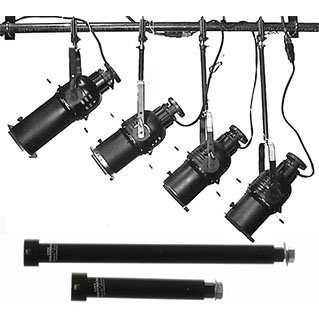
City Theatrical Vertical Extension Tubes (from City Theatrical website, 2018)
Booms
A boom is a vertical scaffold pole, which has fixed to it horizontal boom arms, onto which lanterns can be mounted, to create side light or cross light across the stage.
Depending on height and weight of the lanterns, the top of a boom may need to be hung from a rope attached to the grid at the top of the fly tower, and mounted in a base which is screwed to the stage floor. A shorter boom with less weight on it may just be weighted at the base. A boom base consists of a flat metal plate with a short socket mounted on it into which the vertical boom is fitted. A bolt through the socket and boom ensures the safety of the boom. Weights are placed on the metal plate of the boom base to hold it in place.
A ‘tank trap‘ is the best boom base to use as it’s a heavy metal plate with a suitably long socket to keep the boom upright (see photo below).
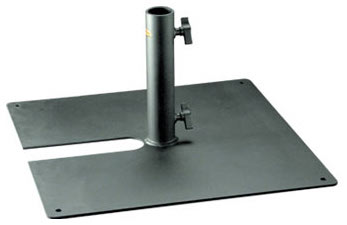
Doughty Engineering Tank Trap boom base
Great care should be taken when using booms in crowded wings, or where there are lots of children on stage, as the lanterns may be at a dangerous height, and the weights are a trip hazard.
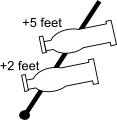
Booms are an integral part of dance lighting, and there are traditionally three heights at which lanterns are placed, which correspond to the dancers’ bodies on stage.
- Shins – the lantern is just above floor level.
- Mids – rigged just above waist height
- Heads – rigged at head height.
Profiles are used for dance side lighting as a greater degree of control is possible over the beam quality and sharpness of the edge of the light.
On a lighting plan, the boom is drawn as a diagonal line, with a circle at one end indicating the bottom of the boom. Lanterns are then drawn on the boom, with a note indicating their height relative to the bottom of the boom, as shown right.
Ladder
A flown vertical structure at the side of the stage, used for cross lighting, but with the added advantage of being able to be flown out to allow scenery to leave the stage.
A ladder can also be rigged onto a bar, using a system comprised of a number of H-shaped frames.
Doughty Engineering make a range of modular rigging equipment which can be used in a variety of ways:
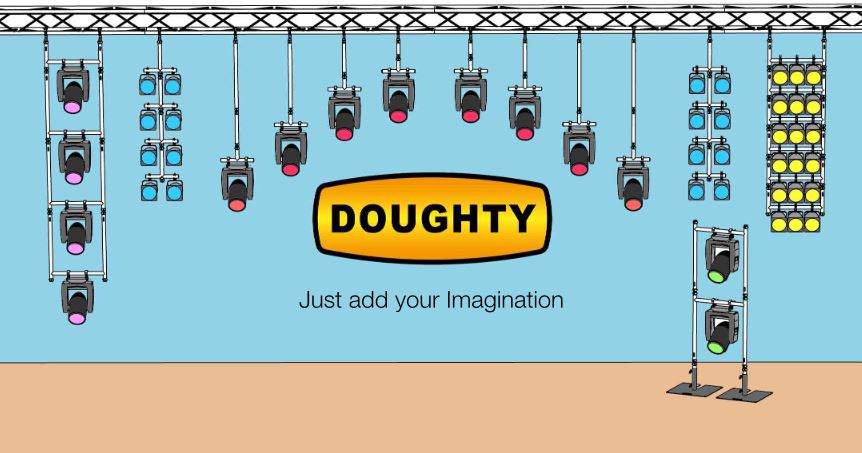
Doughty Modular Rigging System – see text below for description
The diagram above shows 6 rigging configurations, from left to right:
1. Three large ‘H’ frames topped with a pair of trigger clamps and a small ‘H’ frame suspending four moving lights.
2. Four Tees with thru connectors in a ladder configuration, shown with parcans or similar.
3. An arc of Modular Tees with various extensions to create this shape. These can be made more rigid for larger luminaires by using an inverted Tee at the top and connecting to the truss with two parallel couplers.
4. Four Tees with thru connectors in a ladder configuration, shown with parcans or similar.
5. A Pair of large ‘H’ frames connected to two tank trap adaptors and placed in two tank traps creating a floor standing assembly.
6. A large bank or parcans or similar suspended on two clamps/couplers with six small ‘H’ frames connected.
Stands
Telescopic stands are used to lift a single lantern to a suitable height.
Multiple lanterns can be used on a stand with a T-Bar. Care should be taken to ensure that the weight capacity of the telescopic stand is not exceeded.
If the stand is very high, weights should be used to lower the centre of gravity to stop the stand falling over if knocked.
Extreme care should be taken if young performers are likely to be around tall stands.
Doughty Engineering make a good range of stands (see photo below). Adaptors can be used at the top of the stand to connect either an individual lantern or a scaffold T bar).
Ground-Supported Truss
Information coming soon
On the Floor
A low ‘bench’ stand can be used to safely anchor a lantern at floor level. These can be easily made using a piece of plywood and a ceiling saddle clamp (see photos below). Doughty Engineering have recently released a floor stand (known as a Par Can Floor Plate) in which the hook clamp can remain in place, saving a lot of rigging time. They also make a wide range of other floor mount options.
On a lighting plan, a lantern on a bench stand or a telescopic stand is drawn with three ‘legs’ indicating the legs of the stand (see right). The key (or a note adjacent to the symbol) should indicate whether it’s a bench or telescopic stand, and if it’s a telescopic stand, the height of the lantern.
On the Set
Small lanterns such as birdies or small fresnels may be screwed to the set.
Rigging in non-theatrical spaces
Suspending lights from above
This should only be done by a qualified and suitably experienced person. Never attempt to hang lights from any support point that is not specifically designed and installed for that purpose.
Hanging from Suspending Ceilings / Ceiling Tiles
The suspended ceiling system is only designed to support the weight of the ceiling tiles, so never hang any other equipment from a ceiling tile system.
Ground-Supported Systems
The safest way is to use lighting support stands which sit on the floor. Examples are telescopic lighting stands or lighting booms using boom bases (also known as Tank Traps)
This page was written by Jon Primrose, and was first published in February 2016. The latest additions were made in May 2021.
lights hanging positions, light positions, lighting positions, lighting rigging positions, lights positions, walk way above audience used to hang lights





